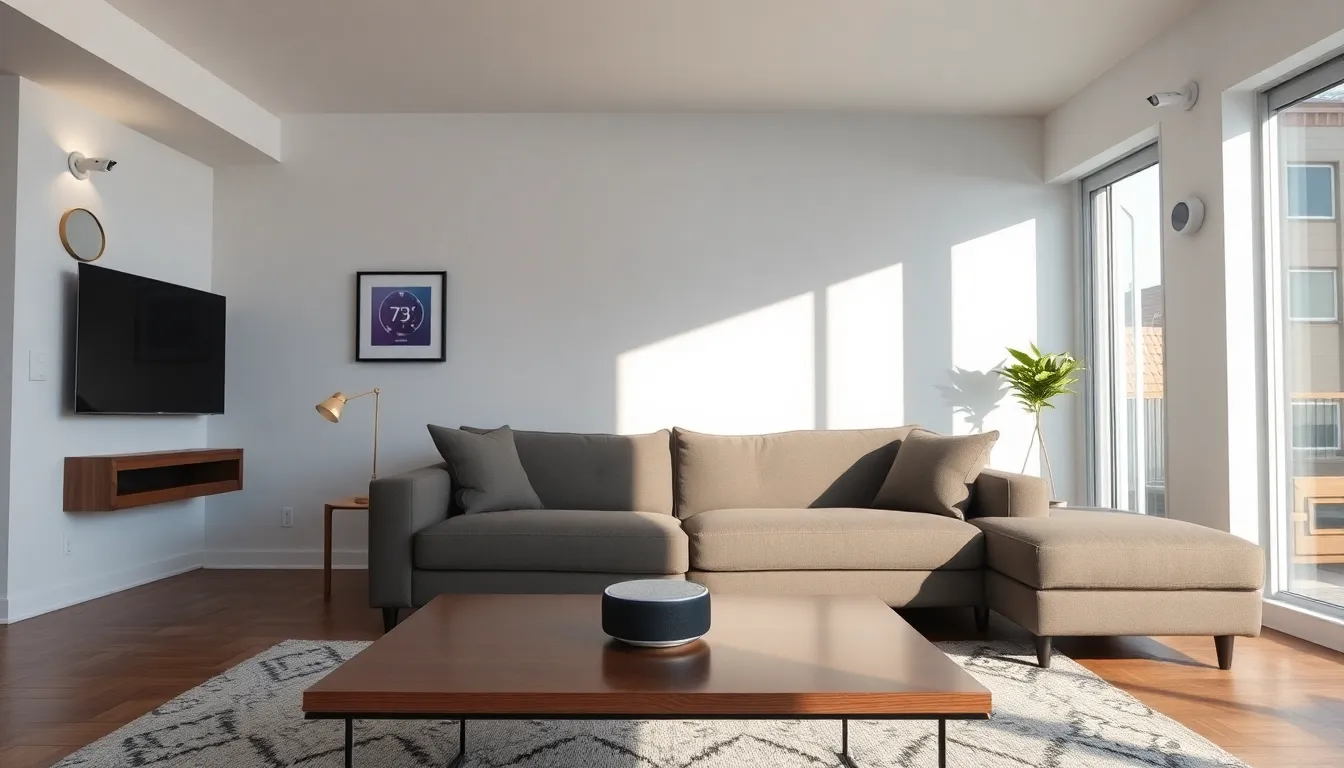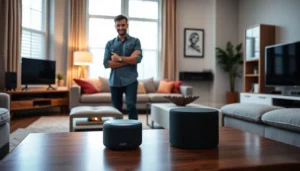Table of Contents
ToggleIn today’s fast-paced world, home tech syncing isn’t just a luxury; it’s a necessity. Imagine a life where your coffee machine knows when you wake up, your thermostat adjusts to your preferred temperature, and your favorite tunes start playing as soon as you step through the door. It’s like living in a sci-fi movie, minus the flying cars and overly dramatic robots.
Home tech syncing makes everyday life smoother and more enjoyable. With a few simple connections, devices can communicate and work together seamlessly. No more fumbling with remotes or juggling apps like a circus performer. Instead, he can sit back, relax, and let technology do the heavy lifting. Get ready to transform your home into a smart sanctuary that anticipates your needs and keeps you living your best life. Who knew being lazy could feel this sophisticated?
Overview Of Home Tech Syncing
Home tech syncing integrates various devices into a cohesive system that enhances convenience and efficiency in daily activities. This technology has made seamless interactions among appliances, making it essential for modern households.
Definition And Importance
Home tech syncing refers to the process of connecting multiple smart devices so they can communicate effectively. This connectivity improves functionality and simplifies home management. Integration of devices like smart speakers, security systems, and lighting controls plays a crucial role in creating a cohesive environment. Without this syncing, managing different devices with separate controls can become tedious. Efficient tech syncing creates a more streamlined lifestyle and elevates the overall user experience.
Benefits Of Home Tech Syncing
Home tech syncing offers numerous advantages for users. Firstly, it enhances convenience by allowing control of all devices through a single platform. Secondly, energy efficiency increases, as synced devices can optimize usage based on household routines. Thirdly, improved security occurs with integrated monitoring systems that can alert users to unusual activity. Automation features add another layer of benefit, as they enable devices to perform tasks without manual intervention. Lastly, customization options allow users to modify settings according to personal preferences, creating a truly personalized home environment.
Popular Home Tech Devices

Home tech devices play a significant role in creating a connected living environment. These devices enhance convenience and improve daily life.
Smart Speakers
Smart speakers serve as central hubs for home automation. They allow users to control music, lighting, and other smart devices via voice commands. Devices such as Amazon Echo and Google Nest provide music streaming services and integrate with various apps. Many smart speakers support routines, enabling users to set multiple actions with a single command. This functionality enhances ease of use throughout the home.
Smart Thermostats
Smart thermostats optimize home heating and cooling systems. These devices learn user preferences over time, allowing automatic adjustments to maintain comfort. Nest and Ecobee are popular smart thermostat models that offer mobile app controls. Energy savings result from optimizing heating and cooling schedules based on user patterns. Remote temperature control also helps ensure energy efficiency when homeowners are away.
Security Cameras
Security cameras enhance home safety and monitoring. They provide real-time video feeds and recording capabilities, offering peace of mind for homeowners. Brands like Ring and Arlo offer models with features such as motion detection and night vision. Integration with mobile devices allows users to receive alerts and check footage from anywhere. This comprehensive overview of security enhances the protection of homes and families.
Synchronization Methods
Home tech synchronization occurs through multiple methods, each offering unique advantages. These methods enable seamless connectivity between smart devices, enhancing the functionality of modern homes.
Wi-Fi Connectivity
Wi-Fi serves as the backbone for most smart home devices, providing high-speed internet access. Smart speakers, security cameras, and smart thermostats often rely on Wi-Fi for remote control and communication. Stability is key; a robust Wi-Fi connection ensures uninterrupted device performance. Devices connected to the same network can share data, allowing for coordinated action. For instance, a smart thermostat can adjust home temperature based on alerts from smart weather stations.
Bluetooth Connectivity
Bluetooth offers a short-range wireless solution for device syncing, ideal for areas where Wi-Fi signals may not reach. Smart locks and fitness trackers often utilize Bluetooth for quick connections. Simplifying control, users can manage devices directly from smartphones without relying on a central hub. While range limitations exist, the ease of setup and instant connectivity are notable benefits. Enhanced privacy also comes with Bluetooth, as data remains local unless shared intentionally.
Zigbee And Z-Wave Protocols
Zigbee and Z-Wave are specifically designed for smart home environments, emphasizing low power consumption and efficient networking. Smart bulbs and home sensors frequently utilize Zigbee for communication, while Z-Wave is popular among home security systems. These protocols function on mesh networks, where devices communicate with each other and extend range effectively. Interoperability allows various brands to work together under one protocol, creating a cohesive smart home system. Both options excel in reliability and security, ensuring safe and effective home management.
Challenges In Home Tech Syncing
Home tech syncing presents several challenges that can hinder optimal functionality and user experience. Addressing these issues ensures a smoother operation of smart systems.
Compatibility Issues
Devices may not integrate seamlessly due to differing standards and protocols. Manufacturers often create products that work within their own ecosystems, leading to reduced interoperability. Smart devices from various brands might struggle to communicate effectively, creating frustration for users. Users often find it necessary to research compatibility before purchasing new tech to avoid integration problems. Consequently, this may limit their options when expanding their smart home setups.
Network Security Risks
Connected devices can expose households to security vulnerabilities. Weak default passwords and lack of updates leave many devices susceptible to hacking. As a network grows, the potential for unauthorized access increases, making strong security measures crucial. Homeowners must regularly check and update firmware to mitigate these risks effectively. It’s essential to employ secure networks and strong passwords to ensure that personal information stays protected from cyber threats.
Future Trends In Home Tech Syncing
Home tech syncing is on the brink of rapid evolution. Innovations in automation are set to redefine the smart home experience.
AI Integration
AI technology increasingly shapes home tech syncing. Smart devices learn user habits, adapting settings for energy efficiency and comfort. Voice recognition enhances interaction, allowing natural dialogue with devices. Numerous home assistants use AI to create personalized routines, making life simpler. For example, routines can adjust lighting according to time of day or context. Smart appliances can automatically reorder supplies or suggest recipes based on inventory, showing a deep understanding of user needs. As these technologies further develop, AI’s role in home automation will expand, leading to truly intuitive living environments.
Enhanced User Experience
Improved user experience remains a central focus for future home tech syncing. Seamless integration drives user satisfaction, allowing control across multiple devices from a single platform. Smart interfaces provide simple navigation, making it easy for users to manage complex systems. Customization becomes paramount, as individuals desire tailored functionalities that suit their lifestyles. Users can set preferences for temperature, lighting, or security measures, streamlining interactions with technology. With ongoing advancements, intuitive designs and responsive feedback will enhance satisfaction, ensuring users enjoy smooth operation and effortless control over their connected environments.
Embracing home tech syncing transforms daily life into a seamless experience. By integrating smart devices into a cohesive system, individuals can enjoy enhanced convenience and efficiency. The benefits are clear—centralized control, energy savings, and improved security all contribute to a more enjoyable living environment.
As technology continues to evolve, the potential for smarter homes grows. Future innovations will likely bring even greater customization and intuitive interactions. Prioritizing security and compatibility will be essential for maximizing the advantages of connected living. Those who invest in home tech syncing today will find themselves at the forefront of a more efficient and enjoyable lifestyle tomorrow.




